“To know, we must imagine ourselves”
a comics workshop to re-construct the migratory experiences of children and youth in Mexico City
DOI:
https://doi.org/10.54871/cl4c500oKeywords:
migration, migrant children and youth, visual narratives, participatory methods, memoryAbstract
The increasing flows of migrant children and adolescents in Latin America call for methodological strategies that propose new ways of accessing their migratory experiences. This article presents the results of research conducted in a migrant shelter in Mexico City. The questions that guided the research aimed to understand the migration experiences of children and adolescents from Central American countries during their stay in the shelter. Among other methodological strategies, a comics workshop was held to produce visual narratives. Based on a reconstruction of the methodology used, the migration experience of a young person staying at the shelter is narrated. The results show that participatory strategies for the production of visual narratives, can give shape to an imaginary that allows a better understanding of the migration phenomena of children and adolescents.
Downloads
References
Arfuch, Leonor (2005). El espacio biográfico. Dilemas de la subjetividad contemporánea. Buenos Aires: Fondo de Cultura Económica.
Arfuch, Leonor (2018). La vida narrada. Memoria, subjetividad y política. Villa María: Eduvim.
Benjamin, Walter (2016). El narrador. Santiago de Chile: Metales Pesados.
Ceja, Ireri; Soledad Álvarez Velazco y Ulla Berg (coords.) (2021). Migración. Buenos Aires: CLACSO.
Chouliaraki, Lilie (2017). Symbolic bordering: The self-representation of migrants and refugees in digital news. Popular Communication, 15(2), 78-94. doi:10.1080/15405702.2017.1281415.
Chouliaraki, Lilie y Stolic, Tijana (2017). Rethinking media responsibility in the refugee “crisis”: a visual typology of European news. Media, Culture and Society, 39(8), 1162-1177, doi:10.1177/0163443717726163.
Das, Veena (2015a). Adjacent Thinking: A Postscript. En Roma Chatterji (ed.), Wording the Word. Veena Das and Scenes of Inheritance (pp. 372-399). Nueva York: Fordham University Press.
Das, Veena (2015b). Affliction: Health, Disease, Poverty. Nueva York: Fordham University Press.
Das, Veena (2020). Textures of the ordinary. Doing anthropology after Wittgenstein. Nueva York: Fordham University Press.
Didi-Huberman, Georges (2004). Imágenes pese a todo. Memoria visual del holocausto. Barcelona: Paidós.
Felman, Shoshana (2019). Testimonio. Crisis del testigo en literatura, psicoanálisis e historia. Buenos Aires: Marmol-Izquierdo.
Gallagher, Michael (2008). “Power is not an evil”: Rethinking power in participatory methods. Children’s Geographies, 6(2), 137-150, doi:10.1080/14733280801963045
Gerber Bicecci, Verónica (2017). Conjunto vacío. Logroño: Pepitas.
Gleeson, Kate y Frith, Hannah (2004). Pretty in Pink: Young Women Presenting Mature Sexual Identities. En Anita Harris (ed.), All About the Girl. Culture, Power, and Identity (pp. 103-113). Nueva York: Routledge.
Glockner Fagetti, Valentina (2008). De la montaña a la frontera. Identidad, representaciones sociales y migración de los niños mixtecos de Guerrero. Zamora: El Colegio de Michoacán.
Horton, John y Kraftl, Peter (2006). Not just growing up, but going on: Materials, spacings, bodies, situations. Children’s Geographies, 4(3), 259-276, doi:10.1080/14733280601005518
Koldzic, Almir y O’Brien, Dan (2015). Taking control of the camera. Index on Censorship, 44(1). 17-23, doi:10.1177/0306422015572972
Kugler, Olivier (2015). A very human picture. Index on Censorship, 44(1), 50-52. doi:10.1177/0306422015570526
La Voz del Interior (31 de marzo 2019). Completo, el magistral discurso de María Teresa Andruetto para el cierre del Congreso de la Lengua. https://www.lavoz.com.ar/numero-cero/completo-magistral-discurso-de-maria-teresa-andruetto-para-cierre-del-congreso-de-lengua
Luiselli, Valeria (2016). Los niños perdidos (un ensayo en cuarenta preguntas). Ciudad de México: Sexto Piso.
Luttrell, Wendy (2010). “A camera is a big responsibility”: A lens for analyzing children’s visual voices. Visual Studies, 25(3), 224-237. doi:10.1080/1472586X.2010.523274
Meda, Juri (2014). Los dibujos infantiles como fuentes históricas: perspectivas heurísticas y cuestiones metodológicas. Revista Brasileira de História da Educação, 14(3), 139-165. doi:10.4025/rbhe.v14i3.605
Mitchell, Mary (2015). Who tells the stories? Index on Censorship, 44(1), 31-33. doi:10.1177/0306422015570562
Morrow, Virginia (2008). Ethical dilemmas in research with children and young people about their social environments. Children’s Geographies, 6(1), 49-61. doi:10.1080/14733280701791918
Organización Internacional para las Migraciones, OIM (2018). Directorio de Casas y Albergues para Personas Migrantes, Ciudad de México. https://mexico.iom.int/system/files/Publicaciones/Directorio de Casas y Albergues para personas migrantes digital_0.pdf
Oyarzun, Pablo (2016). Introducción. En Walter Benjamin, El narrador (pp. 7-44). Santiago de Chile: Metales Pesados.
Penchaszadeh, Ana Paula (2017). Hospitalidad, con y sin papeles. REMHU: Revista Interdisciplinar da Mobilidade Humana, 25(50), 47-64. doi:10.1590/1980-85852503880005004
Richardson, Laurel (2003). La legitimidad de la escritura. Propuesta educativa, 1(15), 1-13 http://propuestaeducativa.flacso.org.ar/revista/indice-n26/
Shire, W. (2011). Conversations About Home (at the Deportation Centre). En Teaching My Mother How to Give Birth. Londres: Flipped Eye.
Shire, Warsan (2015). “Home” by Warsan Shire. Facing History and Ourselves. Global Immigration. https://www.facinghistory.org/standing-up-hatred-intolerance/warsan-shire-home
Schreiber, Rebecca (2018). The Undocumented Everyday. Minneapolis y Londres: University of Minnesota Press.
Snell, Heather (2016). Shifting Places. Jeunesse: Young People, Texts, Cultures, 8(1), 1-19. doi:10.1353/jeu.2016.0000
Spyrou, Spyros (2011). The limits of children’s voices: From authenticity to critical, reflexive representation. Childhood, 18(2), 151-165. doi:10.1177/0907568210387834
Williams, Federico (2022). Formas de inclusión educativa de infancias y juventudes migrantes en la Ciudad de México. Voces y Silencios. Revista Latinoamericana de Educación, 12(2), 21-42. https://doi.org/10.18175/VyS12.2.2021.2
Yates, Lyn (2010). The story they want to tell, and the visual story as evidence: young people, research authority and research purposes in the education and health domains. Visual Studies, 25(3), 280-291. doi:10.1080/1472586X.2010.523281
Zigarán, Iván (2018). El monte, crianza y predación. Una historia etnográfica sobre la relación de las familias campesinas de APENOC con el monte en el marco de la implementación de la ley de bosques. Tesis de Licenciatura. Facultad de Filosofía y Humanidades, Universidad Nacional de Córdoba.
Downloads
Published
How to Cite
Issue
Section
License
Copyright (c) 2023 Federico Williams

This work is licensed under a Creative Commons Attribution-NonCommercial-ShareAlike 4.0 International License.








